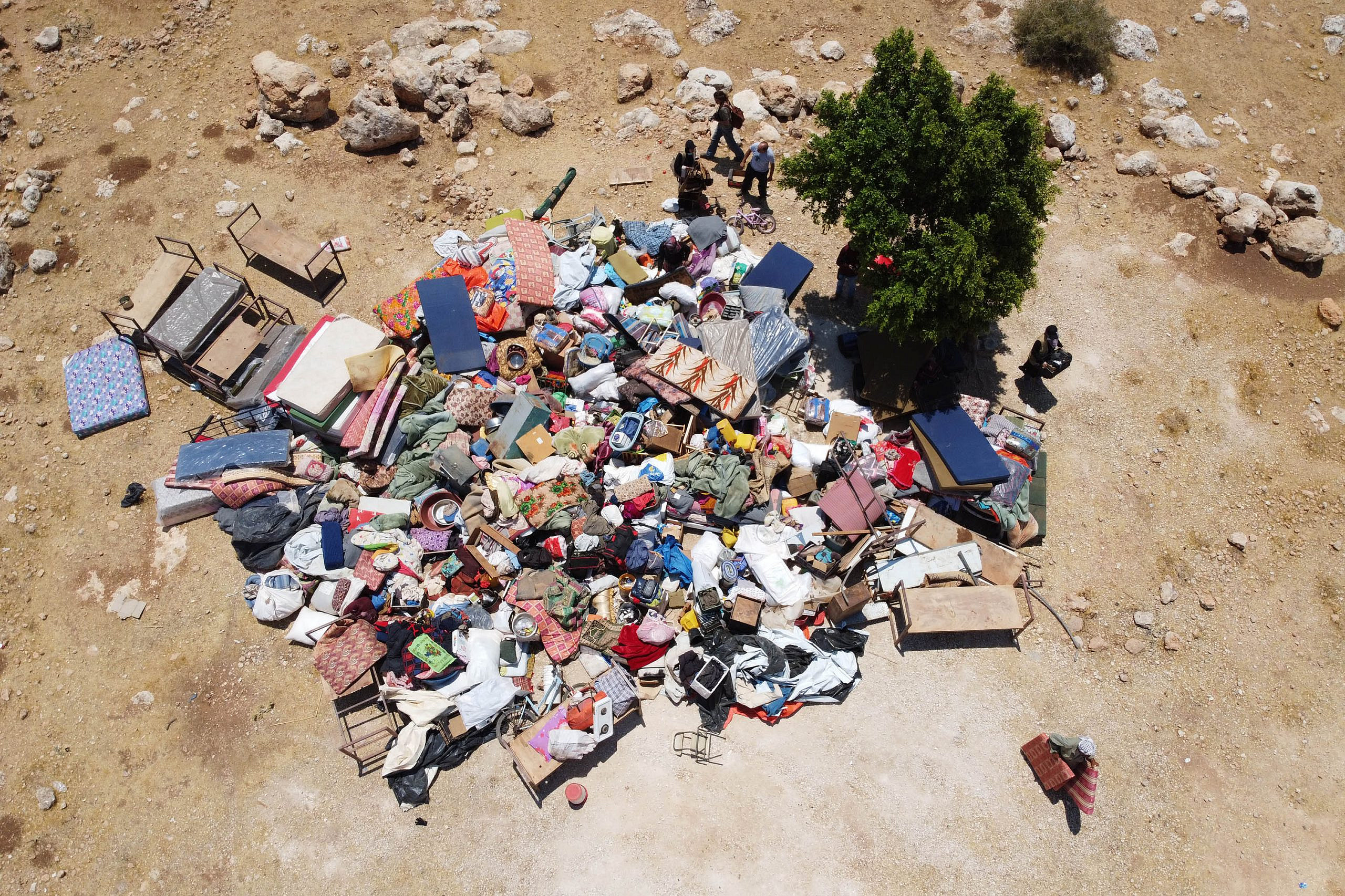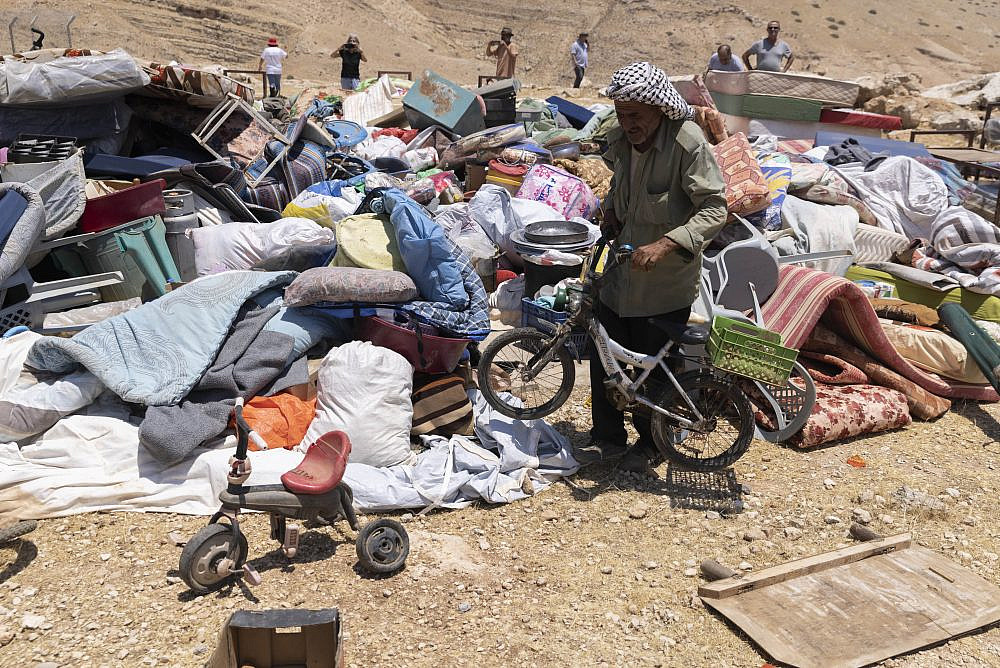On Wednesday morning, in temperatures reaching past 104 degrees Fahrenheit, Israeli forces demolished the Palestinian village of Khirbet Humsa in the occupied West Bank for the sixth time in less than a year.
Israeli military and Civil Administration forces arrived at the Jordan Valley village at around 7 a.m. and began dismantling residents’ tents, confiscating them and loading them — along with their contents — onto an army truck. The truck then deposited the equipment over seven miles away. The IDF brought civilian buses to the site where the residents’ homes and belongings had been unloaded; however, the residents did not board the vehicles for fear that they were going to be expelled even further away. Instead, they fled for the hills and stayed until the army had left, around 6 p.m.
According to the UN Office for the Coordination of Humanitarian Affairs (OCHA), the Civil Administration — the Israeli military’s administrative arm in the West Bank — demolished 27 residential structures and animal shelters, as well as water tanks. They also took food packages, effectively leaving the community without food and water. Israeli forces further confiscated personal items, including milk for children, clothes, personal hygiene products, and plants. Eleven households, which were home to around 70 people — including 36 children — lost their dwelling.
Israeli human rights group B’Tselem characterized the demolition as “abuse of the community’s residents,” and noted that the aim of the operation was to “forcibly transfer [Khirbet Humsa’s residents] from their place of residence and to take over their land.” The organization forcefully rejected Israeli claims that they had received the residents’ consent to carry out the demolition.
Khirbet Humsa is located in an isolated area of the Jordan Valley in Area C of the West Bank, which is under full Israeli security and administrative control. The village is close to the settlements of Ro’i and Bekaot, and reachable only via an unpaved road. During winter, the area is only accessible with an SUV.
The community’s residents live on privately-owned Palestinian land, on which they pay rent. They have been there for 60 years, and are spread out in four different encampments. Each encampment houses two or three families, and is not connected to water, electricity, or sewage infrastructure.
In August 1967, a few months after Israel occupied the West Bank, the army designated the area a firing zone, where the military conducts training exercises. According to OCHA, Israel has classified around 18 percent of the West Bank as a military training area, affecting around 5,000 Palestinian residents. The Israeli authorities thus consider Khirbet Humsa’s residents “trespassers,” even though they lease the land from its Palestinian owners.

Twenty-four hours after the demolition had concluded, the villagers were left without shelter from the sun and without basic necessities. The army’s confiscation of most of their personal belongings differed from previous demolitions, in which they usually took mattresses, nylon sheets, and blankets, and left the rest.
“The truck took everything,” said Walid Abu al-Kabbash, as he sat next to his destroyed home in the punishing heat. “This time round they left nothing. They took the flour and the water. Yesterday we were left in the sun for hours and they prevented media, diplomats, and aid organizations from coming here. When we tried to take photographs, they told us we weren’t allowed.”
Abu al-Kabbash noted that the first time the army demolished Khirbet Humsa was in November last year, and the community was left with no shelter from the rain while access to the village was blocked off by mud. “They arrive on the hottest or rainiest day of the year,” Abu al-Kabbash said. Pointing to nearby water and electricity infrastructure, he added: “Is this the law? A hundred meters from here there’s water and electricity, yet we have nothing.”
Musa, a Palestinian who came to help relatives after the demolition, said: “Would you take their place, living without water and electricity like this? And even the minimal amount they have, they’re not allowed to keep. There’s no [army] base or settlement here, and yet they carry out a demolition and leave them in this state.”
Commenting on the buses brought by the army, Walid, another resident of Khirbet Humsa, said that they were going to take the village’s women and children away. The army denied that it was planning to expel the community, but the demolition of their homes and the confiscation of their belongings convinced the residents that the intention was to evict them.
“It’s a transfer attempt,” said Dafna Banai, an activist with the Israeli feminist activist group MachsomWatch, who is in the Jordan Valley every week. “They didn’t take everything during previous [demolitions]. This time they left people with just the clothes they were wearing. [The army] tossed the residents’ belongings where they wanted to move them to.”

On Thursday afternoon, three IDF jeeps pulled up in Khirbet Humsa and ordered Israeli activists, journalists, and NGO workers to leave, threatening to confiscate their vehicles. One soldier said that the army had “suggested [to the residents] that they go elsewhere, and they refused.” Banai did not elaborate on why they refused.
The IDF Spokesperson said that journalists were barred from accessing the site due to “military activities.” However, according to activists, the soldiers’ only activity was preventing anyone from witnessing or documenting the extent of the damage being done to Khirbet Humsa.
The previous demolition of the community, undertaken in winter, provoked an international incident and was condemned by European diplomats. Ismail Abu al-Kabbash, another Khirbet Humsa resident, nonetheless said he is disappointed in the international community. “After the demolition in November, Americans and Europeans came and toured the area, but nothing changed. I’m worried about people and children, not about possessions. I’m in shock over what’s happened.”
Amid, 6, who was sheltering from the sun in a tent about half a mile away from his demolished home, asked why the army had confiscated his bicycle. His bike allowed him not only to play, he explained, but also to travel between different communities in the area.
Residents and Israeli activists found Amid’s bike in Ein Shibli, a village about 7.5 miles from Khirbet Humsa. It was in a huge pile of the belongings the army had confiscated, and which they had left on top of an empty hill, out in the sun, with no fencing or protection. On Thursday, several community members went to search for their clothes and other possessions.
Israel has demolished, confiscated, or compelled owners to demolish at least 421 Palestinian structures in the West Bank so far in 2021, according to OCHA. When compared with the same period in 2020, these figures represent a 24 percent increase in the number of structures demolished or confiscated, including an almost 110 percent increase in the number of donor-funded structures chosen for demolition, and a more than 50 percent increase in the number of people displaced as a result.
In a statement released following the demolition, B’Tselem called the operation “part of an Israeli policy applied across the West Bank that is intended to create intolerable living conditions, with the aim of making Palestinians leave their homes and then concentrating them in enclaves in order to take over their land.
“This policy is an attempt at forced transfer, which is a war crime under international humanitarian law,” B’Tselem’s statement said.
Mossi Raz, a Knesset member with Meretz, asked Defense Minister Benny Gantz to halt demolitions in Area C. “The state has a responsibility to protect those communities that are regularly evicted and are not entitled to assistance from their side,” Raz said. Nonetheless, he added, “it seems that the state is instead working harder to forcibly evict these communities while abdicating their basic human responsibility toward them.”
The Civil Administration said that the demolition was carried out in accordance with a Supreme Court ruling, and that the “enforcement operation… included demolition and confiscation of tents that had been illegally put up again by Palestinians who trespassed in 2012 into a firing zone in the Jordan Valley.”
This article was first published in Hebrew on Local Call. Read it here.


